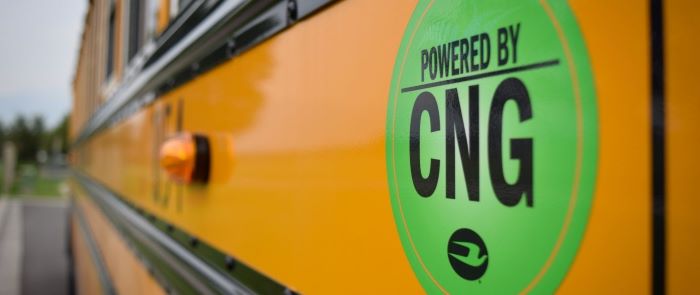March 2, 2021
Natural Gas School Buses Reward Utah District with Fuel Savings
Every day, Utah’s fleet of 2,987 school buses transports 195,000 children to their local schools. Of these buses, serving 41 school districts and charter schools across the "Beehive State," most run on diesel. But in an effort to reduce pollution and adopt alternative sources of fuel, some Utah school districts are adding compressed natural gas (CNG) to their fleets, a move that can offer a sizable pollutant reduction benefit for improved air quality.
Jordan School District (JSD) is one such district embracing CNG school buses to reduce air pollutants and save money on fuel. JSD serves more than 56,400 children in the northern Utah communities of Bluffdale, Copperton, Herriman, Riverton, South Jordan, and West Jordan. JSD began integrating CNG buses into its fleet 15 years ago, a trend that has grown to make the district the largest fleet of CNG buses in the state. Today, the district’s 120 CNG school buses represent nearly 45% of its fleet and offset 60,282 diesel gallon equivalents a year.
Grant Funding Supports Success
Switching to CNG can require a sizable upfront support, as CNG school buses often cost $25,000 to $30,000 more than conventional diesel models. To help offset that larger price tag, JSD worked with the Utah Clean Cities Coalition to learn about grants and funding opportunities. One of these was an approximately $14,000 federal grant, which Utah Clean Cities helped the district apply for when initially adopting the buses.
JSD also applied to a series of other federal and state cost-share grants, which funded 48 of the district’s CNG school buses. In addition to U.S. Department of Energy funding, JSD received a grant from the federal government; a Volkswagen Settlement grant from the Utah State Board of Education; and a grant from the Utah Department of Environmental Quality.
Turning those grant applications into real funding took time and effort. According to JSD Fleet Director Paul Bergera, each time a grant was identified the district requested from its shop foreman a list of buses that met the grant criteria. Next, Bergera gathered necessary documentation and completed the application, which a district grant writer reviewed before submission. It was a waiting game after that, as it generally took a couple months to learn whether a grant was awarded.
For JSD, that process paid off. The district replaced the diesel school buses before their normal life cycle, and the grants more than covered the cost difference of purchasing CNG models. The district has realized significant fuel cost savings.
Better Air Quality for the Community
According to Bergera, the motivation to adopt CNG came from the district’s interest in lowering air pollution and improving student and community health. In Utah and Salt Lake County—the state’s most populous county and where JSD is located—air quality can reach unhealthy levels. The air pollutants of primary concern include ozone, formed from nitrogen oxides and volatile organic compounds, and particulate matter. Research shows that high levels of ozone and particulate matter are linked with increased risks for respiratory issues (such as asthma) and cardiovascular harm (such as heart disease). In winter months when temperature inversions increase, levels of particulate matter rise, which can be particularly harmful to children and sensitive members of the community.
For JSD, CNG buses offered an opportunity to help address that problem. For example, the district’s new CNG buses emitted nearly 88% fewer nitrogen oxides than the old diesel buses, according to analysis from Argonne National Laboratory’s Alternative Fuel Life-Cycle Environmental and Economic Transportation Tool. When considering the district’s 120 CNG school buses, that reduction translates into keeping more than 7,300 pounds of ozone-forming nitrogen oxides out of Salt Lake County’s air.
